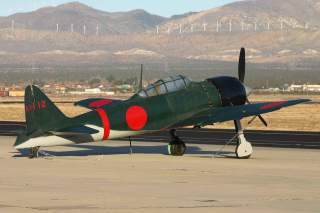How Imperial Japan Launched a 'Second' Pearl Harbor
And this was one move America should have seen coming.
Key Point: If MacArthur and his commanders had taken all the right precautions, if they had acted more quickly and decisively, would it changed the outcome? In the long run, probably not.
At 3 a.m. Philippine Time on December 8, 1941, Gen. Douglas MacArthur was awakened from his slumber by a telephone call informing him that the Japanese had attacked Pearl Harbor just an hour earlier.
At about noon in the Philippines, nearly two hundred Japanese Mitsubishi “Betty” bombers and “Zero” fighters struck Clark Field, America’s main military airbase in the Philippines. The attackers were supposed to arrive at the same time as the Pearl Harbor strike, to maximize surprise and catch American planes on the ground. But takeoff had been delayed by fog over their Taiwanese bases. Arriving at Clark Field after a grueling seven-hundred-mile flight, the tired Japanese pilots expected to find the skies swarming with American fighters.
Instead, the skies were clear. Even better, instead of being safely dispersed to secondary airfields, U.S. planes on the ground were parked wingtip to wingtip, perfect targets for bombs and machine-gun fire. Within minutes, the powerful U.S. air fleet at Clark Field—the backbone of America’s Philippine defenses—had been smashed.
It was a catastrophe almost as devastating as Pearl Harbor. Yet at least Pearl Harbor’s defenders could offer the tepid excuse that they had been caught by surprise tactically, if not strategically. On the other hand, American forces in the Philippines had been alerted nine hours before the Japanese struck.
There would be much blame to go around. But the man who earned the most blame was Douglas MacArthur.
To be fair, while MacArthur was as difficult a general as ever wore stars, the situation he faced would have taxed any commander. Manila is only two thousand miles from Japan, but five thousand miles from Pearl Harbor and seven thousand miles from San Francisco. By the 1930s, Washington had come to realize that Japan’s military strength had grown to the point where defending America’s Philippine colony was impossible. War Plan Orange, the prewar U.S. strategy for a conflict with Japan, anticipated the Philippines would be cut off in the event of war. Nonetheless, the U.S. and Filipino garrison was expected to resist a Japanese invasion, withdrawing to the Bataan Peninsula and denying the use of the strategic port of Manila until the U.S. Navy and Marine Corps charged across the Pacific to relieve the islands.
The strategy wasn’t ideal, but perhaps it was the best that could be done given geographic reality. Yet in 1941, at MacArthur’s urging, the U.S. government belatedly reinforced the Philippines, including dispatching thirty-five precious B-17 heavy bombers. Perhaps the Flying Fortresses, with a range of close to a thousand miles, could disrupt a Japanese offensive in the western Pacific.
Japan’s attack did not come as a total surprise: war had been in the air for months before December 8. Yet the American command was paralyzed by dissension and lassitude. Neither MacArthur, nor his air commander Maj. Gen. Lewis Brereton, made obvious preparations, such as dispersing the aircraft massed on Clark Field to satellite airfields.
“Instead of acting promptly to move the bombers out of range of the Japanese airfields on Formosa, the military leadership at Manila worried about possible sabotage, increased the guard, and bunched the aircraft together to make it easier to protect them from enemy agents,” writes Daniel Mortensen in The Pacific War. “Neither Brereton nor MacArthur paid enough heed to warnings of possible Japanese attack to cancel a Saturday night party in the ballroom of the hotel where MacArthur lived. Crewmen of the B-17s still at Clark Field attended the affair, which lasted until 2 a.m. on December 8, just about the time the first Japanese aircraft attacked Pearl Harbor. Revelers from the bomber squadron carried in their pockets orders to fly to Del Monte on the day after the party.”
When news came of Pearl Harbor, Brereton wanted to immediately launch his B-17s against Japanese airfields on Taiwan. With the Japanese aircraft stranded because of weather, the Flying Fortresses might have caught the Bettys and Zeroes on the ground. But MacArthur and his staff refused permission until 11 a.m. Just an hour later, as U.S. aircraft were being armed and fueled, the raiders arrived.
The results were disastrous. Half of the B-17 force had been dispersed to Mindanao, but of the remainder, twelve were destroyed and four more damaged. Many P-40 fighters were destroyed on the ground or shot down by Zeroes. By the time the attackers finished, half of the Philippine air fleet had been wiped out. The surviving pilots would go on to fight most gallantly, but the Japanese landings would proceed mostly unhindered by American air strikes. By May 8, the last American and Philippine troops had surrendered. Many of the survivors would later die on the Bataan Death March or in hellish Japanese prison camps.
If MacArthur and his commanders had taken all the right precautions, if they had acted more quickly and decisively, would it changed the outcome? In the long run, probably not. By themselves, even the B-17s couldn’t stop the Japanese. But with the main U.S. battle fleet far away, and the 130,000 American and Philippine ground troops poorly trained and armed, airpower was the only real protection for the islands.
On the other hand, the Japanese were operating on a tight timetable that required them to concentrate their forces to capture vital objectives one after the other. Perhaps if U.S. airpower had survived the initial Japanese raids, it might have slowed and disrupted the Japanese blitzkrieg just enough to give the Allies precious time to mobilize their defenses—and hasten Japan’s defeat.
Michael Peck is a contributing writer for the National Interest. He can be found on Twitter and Facebook

